#professer e Gadd
Text
Mario doodle dump timeeee

Old sketch I forgot about, just lightning practice but I liked it :)
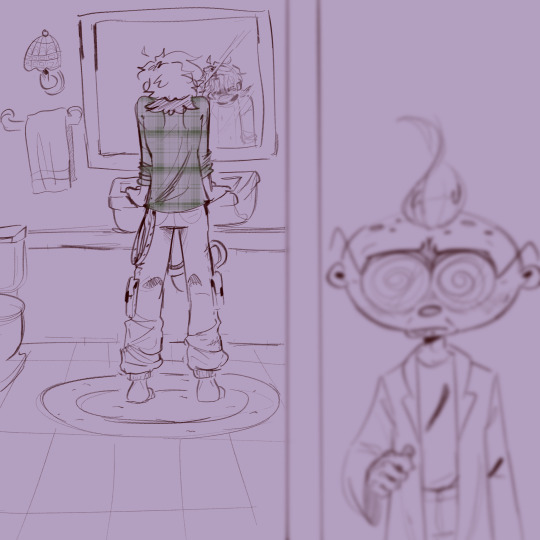

Luigi trying not to have a complete mental breakdown as E Gadd processes his treatment toward the plumber. (Meaning he treats him more like Mario, forgetting about his anxiety and definitely real autism)
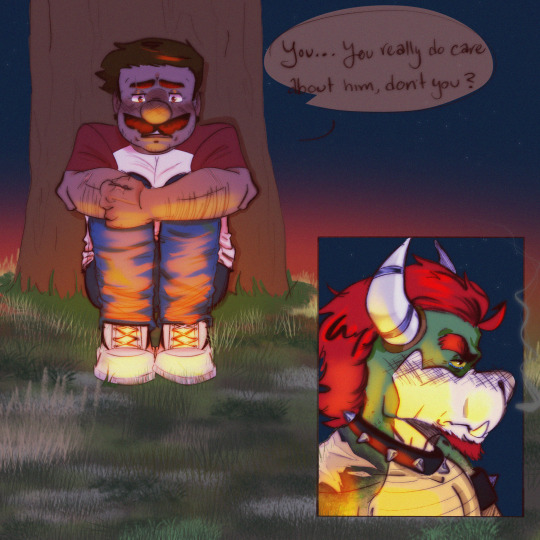
Related to my small Possessed!Luigi thing where Mario, Bowser, Toad, and Peach go out to rescue him. Mario and Bowser are obviously pretty at odds with each other but Mario has no idea about Bowser and Luigi’s relationship.
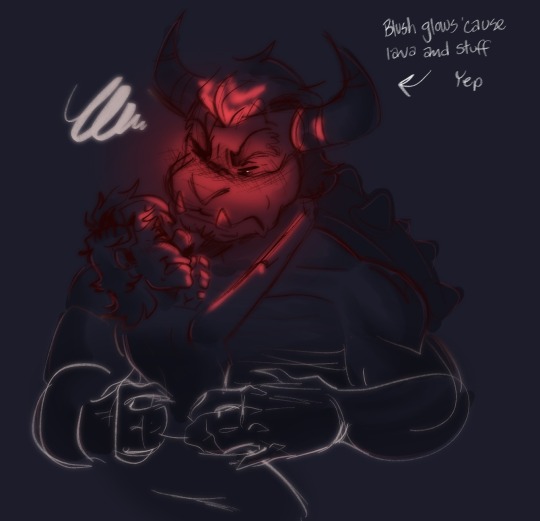
I just think it’s funny. Bowser hates it but Luigi thinks it’s cute and funny, which only makes him blush harder.
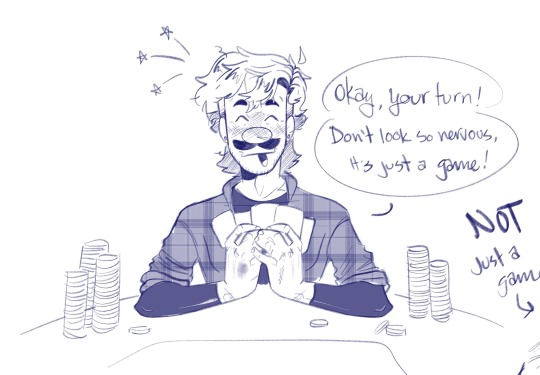

Luigi being a poker master but Bowser doesn’t know that. “It’s called a hustle sweetheart” okay you can shoot me now✌🏻
#guys why can’t I get over Luigi#I’m projecting way to much on this poor green plumber#Mario#bowser#Luigi#sketch#digital art#Luigi’s mansion#professer e Gadd#bowuigi#bowser X luigi#AU#SMB
2K notes
·
View notes
Text
The Super Mario Bros. Redux (Pt. 2)
What would happen if, in The Super Mario Bros. Movie, after Mario and Luigi are separated, Mario was the one who ended up in the clutches of Luigi’s eventual arch nemesis, while Luigi teamed up with some of his own close allies to go rescue him?
Part 1
Part 2
Part 3
Part 4
Part 5
Part 6
________
While on the train, E. Gadd and Luigi mostly keep to themselves. Luigi stares silently out the window trying to absorb everything that's happened while the professor tinkers with his vaccuum device, which Luigi now knows to be The Poltergust 3000. However, as night begins to fall, E. Gadd finally breaks the silence between them.
He asks about the tools Luigi carries and mentions that though they seem to be mainly for plumbing, there's a few mixed in that are better suited for engine repair. Luigi explains that while he and his brother's main profession is as plumbers, he does like to tinker a little– mostly fixing up the van or repairing household appliances.
E. Gadd seems happy to meet another tinkerer– even one so inexperienced in comparison– and asks Luigi if he ever considered a change of careers. Luigi declines, insisting he'd never leave his brother, saying he is "twice the plumber than I am a mechanic."
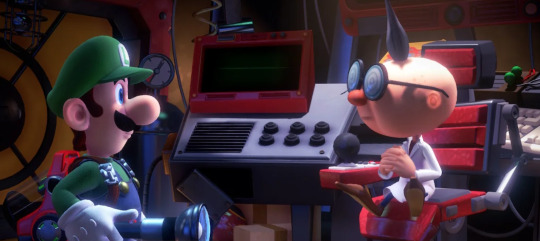
E. Gadd notes how much Luigi seems to admire his brother. Luigi confirms wholeheartedly and gushes about how great Mario is until he gets caught up in how much he misses him. Not wanting to make a scene by getting choked up, he distracts himself by asking E. Gadd about his work, and if he himself has a partner.
The Professor explains he's an inventor, and though his experiments are fairly eclectic his main area of expertise is ghosts and spirits. As for a work partner, he dismisses the very notion. He has happily lived and worked alone his entire life, and would have been perfectly content to stay that way had ghosts not raided his lab back in Evershade Valley.
Luigi– just now learning that Evershade Valley was E. Gadd's home– offers his condolences, but Elvin shrugs him off and assures that it's fine, as he's already working on a solution.
Suddenly, the train screeches to a stop, and the lights overhead shut off. Luigi starts growing nervous, and assures himself out loud that it's probably only a minor problem, and they'll be back on track in no time.
The Professor isn't so sure. He pulls out his handheld device he had used earlier (which looks uncannily like a Nintendo DS) and examines the readings. He gives a foreboding "oh dear," and Luigi asks what's wrong.
E. Gadd explains that many kingdoms have at least one haunted location, called a "ghost house." The Birabuto Kingdom is no exception, and they were passing by that very house at that moment. While the ghosts who resided there usually kept to themselves unless their home was invaded, the shattered Dark Moon likely allowed them to target any living thing passing through the area.
Then, a creepy, raspy voice comes on over the intercom: "Please remain in your seats. We will be with you shortly! Hee hee hee hee!"
Luigi lets out a little squeak of terror and curls up tighter into his seat. E. Gadd gets up and starts walking toward the engine room, lighting his way with a flashlight at the end of the nozzle of The Poltergust 3000.
"Professor!" Luigi calls in a frightened whisper "What are you doing!?"
"Relax Kiddo, I catch ghosts all the time!" E. Gadd assures, giving Luigi a reassuring pat on the shoulder. "It's like riding a bike for me! You just sit back, I'll be back in a jiffy!"
Professor E. Gadd makes his way to the train's engine room. As he suspected, the drivers are knocked out, and a large band of about ten boos are wreaking havoc. Among them is a ghost dog, though it merely seems to be innocently concerned with the unconscious drivers, playfully sniffing them, nudging them, and bounding around their sleeping bodies.
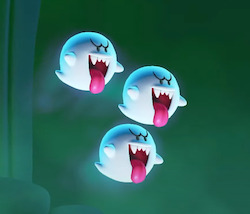

The Professor wastes no time confronting the spirits, but as they fight back he is quickly overwhelmed.
Before any true harm can befall E. Gadd, Luigi suddenly appears in the doorway and rushes to his aid.
With E. Gadd struggling to get back to his feet, Luigi takes possession of The Poltergust and– though visibly panicking– makes quick work of all the ghosts except two: a single boo that flies off through an open window, and the dog ghost who phases into a nearby wall.
E. Gadd, dazed but ultimately uninjured, compliments the still trembling Luigi on his skills with The Poltergust. Though he is a little annoyed that the device was taken without permission, he confesses that the outcome more than makes up for it.
After E. Gadd and Luigi check on the drivers and confirm they too are unharmed, they look over the engine. Thankfully, all damage is surface level, and after getting the lights back on Luigi and E. Gadd work together to get the control panel functioning again.
Then they return to their seats, E. Gadd assuring the confused fellow passengers that it was merely a small electrical error that had now been repaired. After a moment the dazed voice of one of the train drivers speaks over the intercom, apologizing for the delay as the engine revs back up, and Luigi and E. Gadd continue toward the capital of The Birabuto Kingdom.
The scene transitions to Evershade Valley where, deep below the foundations of the mansion Mario had attempted to seek refuge in, phantoms twirl around a grand, ghostly ballroom, overseen by a giant dark-eyed boo in a gemstone crown.
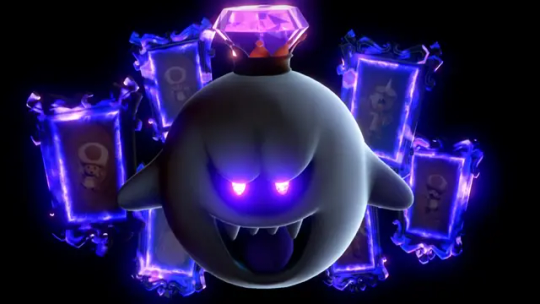
The little boo who had avoided capture on the train suddenly enters. Once he finds the courage to uncover his face, he reports to his king that recent efforts to stop E. Gadd from reaching The Birabuto Kingdom have failed.
King Boo demands to know how the mission could've possibly been a failure considering the numbers they had at their disposal and how frail and weak E. Gadd has gotten over the years.
The boo explains that E. Gadd wasn't alone this time and that another human was with him, young and strong, wielding The Poltergust 3000 in the scientist's stead.
King Boo demands a name. The smaller boo doesn't know, but can give a description: mustachioed, big nosed, and dressed in a hat and overalls.
This intrigues the king. He dismisses the frightened boo and calls upon Boolossus, telling him to bring his newest painting to The Secret Altar beneath the courtyard.
#Mario Movie#Mario Movie AU#Luigi#Super Mario Bros#Super Mario Brothers#King Boo#The Super Mario Bros. Redux#super mario bros redux au
73 notes
·
View notes
Text
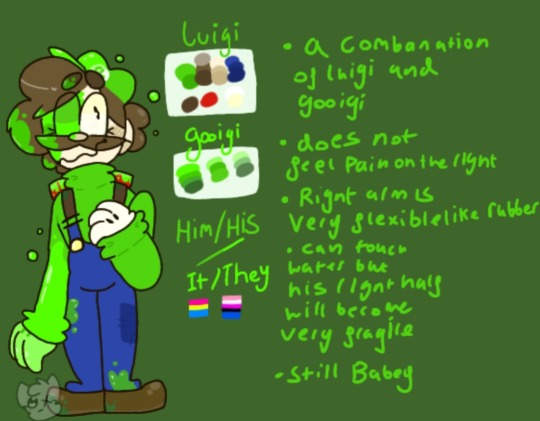


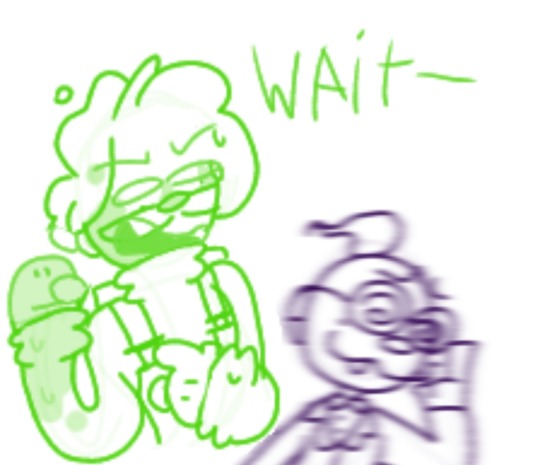
So luigis mansion 3 but E. gadd fucks up on testing gooigi and there now apart of Luigi ghbjghgjj
So this is an idea I made just yestaday and now drawing it
I guess this is an AU?? Or just a random idea I guess since really nothing changes except Luigi so :"))
Anyhow I hope you enjoy this idea or somthing I'll probably draw this more if people want gdgfgfg
#luigi#gooigi#gooigi lm3#luigis mansion#luigis mansion 3#lm3#professer E gadd#E gadd lm3#luigis mansion AU#lm3 AU#gooed tougher AU
141 notes
·
View notes
Text
Haunted Castle
I don't remember what sparked the idea but basically this fic is based off an idea I had for what might be a cool spinoff or something in the Luigi's Mansion series. We see Bowser as an almost good guy sometimes so I think it'd be neat for him to be the person being saved for once. It's never going to happen of course but I still think it'd be neat.
This was supposed to be a quick drabble just setting up the idea, mostly just as a way to sharing the idea, but then it became 2k words long. It's still just the setup for now but I might continue it, I haven't decided yet.
~
It started with just the doorbell ringing. It set Polterpup off into a fit of excited barking but Luigi ignored it. He wasn’t excepting anyone and therefore it couldn’t be anyone he wanted to talk to. But then after maybe a minute, it rang again, quickly follow by another a few seconds later before whoever it was descended into just spamming it.
With a sigh, Luigi put aside his book and careful to avoid being visible through the front window, snuck over to the door. Peeking through the peephole he saw… nothing. But the bell was still going off and Polterpup was going absolutely mad about it. Before he could pull away to attempt to stealthily peek through the window…
“I know you’re in there. I can hear your dog barking. If you don’t let me in, I’m going to bust through your window.” It was muffled by the door but it was still distinctly the voice of a child. It was also familiar, Luigi had heard it multiple times before, though he couldn’t quite place where right now.
With that in mind and not wanting to deal with a child trying to bust through his window, Luigi put a hand on Polterpup’s head to finally calm him before answering the door at last. … Bowser Jr. was on the other side, one clawed hand still raised, pressing the doorbell.
“Finally,” he said as he pulled his arms in to cross them over his bandana, puffing out his chest while he did so. “About darn time. Now uh… uh…” he faltered deflating a little before with a growl he kind of just invited himself in, striding into the middle of Luigi’s living room as if he owned the place.
There wasn’t much Luigi could do to stop him short of using physical force which he didn’t want to do if he didn’t have to. So with a sigh, he closed the front door and turned to face the intruder. “What do you want?”
Whatever it was, he clearly hadn’t planned what he was going to say before getting here as he looked off to the side in silent thought for a few seconds. In the hallway behind him, Gooigi stepped out into the living room. They stayed silent though so Luigi let them be.
“King Boo took over Papa’s castle,” Bowser Jr. finally said, regaining his confidence as he looked back at Luigi. “And you’re going come with me to take it back and beat him up.”
Luigi was shaking his head ‘no’ before Bowser Jr. even finished speaking. He even shook his hands ‘no’ for more emphasis. “No, no, no. I don’t do ghosts.” They were scary and he was done with scary things. He was going to have to call up E. Gadd later and scold him for losing King Boo again. … Assuming he had, this being Bowser Jr. meant it could theoretically be a trap.
Bowser Jr. frowned at him. “You’re a ghost hunter though. You’ve beat up King Boo three times now. Also, I didn’t ask, I said you’re going to and so you are.”
“No!” Luigi was proud of the amount of force he was able to put into it. He was done with scary things and he was not going to take orders like that. “Ask someone else.”
Bowser Jr. faltered again, his shoulders sagging a little as he made a visible effort to maintain a confident demeanor. “But… you’re the only ghost hunter in either this kingdom or my dad’s. So….” he growled, balling his hands into fists at his sides, “you can’t say ‘no’.”
Luigi crossed his arms and turned his head away. “I’m sure that’s not true.” There was no way, right? He knew from experience that it was a rather lucrative endeavor so people who weren’t scared of ghost and wanted to make some good mood should flock to it. “You can ask E. Gadd. He’s not really a ghost hunter, he just studies them. But I’m sure he knows some ghost hunters you could ask. I can even call him for you.” Luigi wasn’t a heartless monster so there was no way he could send Bowser Jr. away completely and he needed to call up E. Gadd anyway. Before he could pull out his phone to do so though…
“E. Gadd’s obviously the first place I went. He’s the one who told me to go to you because you’re supposed to be the best and only ghost hunter left alive. He even gave me your address. So you have to do it because… you just have to, okay?”
Luigi refused to believe he was the ‘only ghost hunger left alive’ because that meant the profession – if it could be called that – was even more dangerous than he’d thought. Just thinking about it made him want to go even less. “I can’t.”
The last of Bowser Jr.’s confidence vanished. “But… but… what am I supposed to do then? He turned Dad and Kamek and all my siblings and… everyone into paintings! I only got away because I hid in the closet like a stupid coward because Dad told me to.”
And now Luigi felt bad, great. He maybe shouldn’t feel bad for someone who was technically an enemy but regardless of anything else Bowser Jr. was a kid who’d witnessed his entire family and probably everyone he’d ever really known get turned into paintings by King Boo. Given those circumstances, it was hard not to feel bad for him and maybe even a little tempted to help him. But… Luigi had already said ‘no’ and he didn’t like ghosts.
He looked back over at Gooigi, still standing in the hall watching. They nodded and gave him a thumbs up. What did that mean in this context? Were they telling him to say ‘yes’ to Bowser Jr.’s ask for help? Or were they approving his ‘no’?
“Let me have you ghost hunting stuff then.” Bowser Jr. stomped his foot and squared up his shoulders as he looked up at Luigi. “I don’t need you, I can just do it myself.
If he wasn’t a child, Luigi probably would’ve handed over the Poltergust and all its attachments with little argument – who was he to stand in the way of someone else catching ghosts, especially in a situation like that? But villainous Bowser’s child or not, he was still just a kid and sending a kid off to fight a castle full of ghosts, boos, and King Boo himself all on his own was just wrong. … And sending him off to look for another ghost hunter when neither of them knew where to even start looking for one was less than ideal as well.
Maybe he could send him off with Gooigi. But could Gooigi handle everything on their own? They were so fragile and their weakness being liquid, made them easy to defeat. An inch-deep puddle of water that couldn’t be navigated around or over would be enough to make it impossible for them to be of any help to anyone. Which meant Bowser Jr. would have to be helping them potentially the whole way which was still asking a kid to run around in a castle full of ghosts and boos, most likely culminating in a fight against King Boo himself.
Oh dear, Luigi’s conscious wasn’t going to let him out of this, was it? … Darn it! Why’d E. Gadd have to go and lose King Boo again? One would think he’d learn from King Boo’s prior escapes resulting in Luigi having to deal with him again. And speaking of that, he was going to go after Mario and Luigi again for sure because he was not the type to let a grudge go. So to protect Mario before he got turned into a painting again and to probably protect himself from a trap later down the line as well, Luigi should go take care of King Boo now when King Boo shouldn’t be expecting him, increasing his chances at another victory. It was the smart thing to do but… Luigi really didn’t want to.
It was so unfair. He just wanted to be done with ghosts and other scary things for forever. Wasn’t facing his worst fear three times more than enough? And… and… he wanted to stick to his guns. He’d already said ‘no’. … Maybe instead he could send Gooigi and someone else, like Mario. Yeah sure, Mario didn’t have any real experience in dealing with proper hauntings or in using ghost hunting equipment but he could learn, right? So that would maybe probably be fine?
“Let’s a-go!”
Luigi looked up to see that Gooigi had apparently left to retrieve the Poltergust from their room which they now carried in front of him. Any question about what their intention might be was erased as the beelined for Luigi with it.
“What is that?” Bowser Jr. asked, taking a step back as Gooigi passed by him.
“Gooigi!” Gooigi introduced themself, twisting their head to look at him in a way that would’ve been unnatural if they weren’t made of goo. Their head snapped back into proper orientation as they reached Luigi. “Let’s a-go.”
“You want us to help him, don’t you?” Luigi asked as if there were actually any question to it.
Gooigi nodded. Of course they did, they’d been brought into existence for the sole purpose of hunting ghosts so it would’ve been odd if they hadn’t wanted to help someone who came to them with his ghost problem.
“You can go. You don’t need me, right? You can ask Mario to go with you to make sure you don’t get into any trouble with water or anything.” And that way Luigi could stay home and not deal with a bunch of ghosts.
Expressionless as always, Gooigi didn’t reply. Instead, they walked around behind him and… pushed the Poltergust to his back. They held it there with one hand as they used their other to maneuver Luigi’s arms into the straps. He could’ve resisted but didn’t because this wasn’t a battle he could win, was it? His conscious, logic, and Gooigi trying to get him to do it made it hard to stick to his ‘no’. Which was not fair at all but there was nothing he could do about it.
“Let’s a-go,” Gooigi said again when they were done, looking at Bowser Jr.
“Uh… what’s going on?” he asked, understandably a bit confused. “Are you two going to help me save my dad now?”
Gooigi nodded and pointed to the door.
“Sweet! Let’s go!” With a grin that made him look even more like his father and namesake, Bowser Jr. hopped into motion, heading for the door. Gooigi followed, tugging on Luigi’s wrist to get him to come along too. And the final nail in the coffin was an excited bark from Polterpup before he grabbed at Luigi’s pantleg to pull him along in the right direction.
Outside on the front lawn was Bowser Jr’s flying clown car. It was a squeeze but the three of them plus Polterpup managed to get into it. The squeeze lessened a bit when Gooigi went back up into the Poltergust’s tank on Luigi’s back.
“Uh… that’s weird,” Bowser Jr. said. “It looks kind of like you but … what is it?”
Luigi sighed. “They’re name is Gooigi. E. Gadd made them to help me hunt ghosts. They’re made of goo and melt when wet.”
“Um… okay. You like for reals going to help me save my dad now though?”
“Yes.” Luigi still would rather not but he wasn’t being given much of a choice. It wasn’t like he hadn’t dealt with hordes of ghosts before though so hopefully he could get this over with fast and maybe convince E. Gadd to get some tighter security protocols on King Boo to hopefully keep him contained this time.
“Awesome!” Bowser Jr. said as he started up the clown car. With the added weight its ascent was a bit more sluggish and unsure than it probably should’ve been but once they got up in the air, there seemed to be little issue as he turned them towards in the direction Bowser’s castle presumably lay in.
“And uh… thank you,” he added with an awkward grin as he looked back at Luigi. Well at least he was being openly grateful now. Bowser and company better be grateful too otherwise Luigi was going to be real mad at them. He’ll have earned the right for some gratitude after this.
50 notes
·
View notes
Text
Different species of ghosts yield very interesting facts. Let’s look into this shall we?
Special thanks to @fluffyfeatheredferret for this one!
There are three species of ghosts: regular ghosts, Boos, and portrait ghosts
Regular ghosts include, but are not limited to Greenies, Slammers, Hiders, Gobbers, Sneakers, Creepers, Poltergeist, Possessor, Goobs, Hammers, Slinkers, Oozers, and Trappers. These ghosts reside in Evershade and at the Last Resort, and live by the night. While direct sunlight won’t kill them, they do get weaker the more time they spend in the sun. These ghosts are known to be generally nice, unless they are being controlled, then they act chaotic.
Note: The stronger (I’m going to dub crystallized) ghosts in Evershade do not loose their crystallization, and are still scarred by the experiments done on them. The remain hidden from the world, scared that King Boo will come back to get them and do more experiments again.
Another note: the ghosts in Luigi’s Mansion are just paintings brought to life. All of those ghosts are destroyed unless Vincent Van Gore is brought out of his painting to paint them again. But as of right now, they are not actually true ghosts.
Boos are a mischievous race that use illusion (Boo Physics Magic), and they live here, there, and everywhere throughout the Mushroom Kingdom. King Boo is their ruler, and he’s rather lax with his ruling, until Boolossus got captured by Professor E. Gadd that he went into rage and started his reign of terror across the regular ghosts and his somewhat ruling of the portrait ghosts. The Boos do go along with his mansion (and hotel) schemes as they get a kick outta scaring Luigi, but they are growing concerned for their king’s sanity. Whether or not King Boo actually stops, we may never know.
Portrait ghosts were once people (and creatures in the case of Jarvis, Spooky, Bogmire, Miss Petunia, the Clockwork Soldiers, and Captain Fishhook), but are now deceased and have come back as ghosts. They usually haunt the place that they died in, which is probably why E. Gadd started putting ghosts into portraits (but that’s a topic for another day). Hence why they are dubbed “portrait ghosts”. Portrait ghosts are stuck in the living world until they have done the thing that let’s them pass on. However, most tend to stay. After all, they can do their profession without getting hurt.
As always, if you have any questions, the ask box is open.
#d chats#luigi's mansion#luigi's mansion dark moon#luigi's mansion 3#greenie#slammer#hider#gobber#sneaker#creeper#possessor#poltergeist#goob#hammer#slinker#oozer#trapper#boo#boolossus#king boo#professor e gadd#e gadd#jarvis#spooky#bogmire#miss petunia#clockwork soldiers#captain fishook#vincent van gore#lillypadwonders
22 notes
·
View notes
Note
What’s E. Gadd and Luigi’s relationship like in your series of stores? Are they business partners? Or do they run individual, potentially competing, ghost-busting services?
E. Gadd is Luigi's mentor, business partner, and, most importantly, a dear friend (Mario and Luigi wouldn't be here today, after all, if he hadn't interfered in the first Luigi's Mansion!).
The professor is a man of science, and thus, addresses matters through a strictly logical mindset. Luigi, while intelligent in his own right, tends to wear his heart on his sleeve, and approaches issues with empathy and compassion. The two have rubbed off on each other over the years, E. Gadd now looking at things with a more open mind and Luigi thinking more critically. Their influences have been invaluable to the growth of their profession, and they wouldn't be nearly as efficient had they chosen not to collaborate.
Oh, and E. Gadd's methods would still be...err... questionable
==
E. Gadd: "Hmm...I wonder how long a Greenie can be engulfed in fire before the heat starts to affect it. Luigi, would you please lure one to the fire retardant room so we may begin the first trials?"
Luigi, rhetorically: "Is...is that ethical??"
E. Gadd, shrugging on a flamethrower: "...ethi what now?"
#Luigi#E. Gadd#Professor E. Gadd#Luigi tries to keep the professor in check#it's not easy#the E in E. Gadd does NOT stand for Ethical it would seem#Professor I Light Sentient Beings on Fire For Science Gadd#I love him but jfc that man needs to chill#LLoG AU#LLoG Asks#E. Gadd Asks#Luigi Asks#suit speaks
75 notes
·
View notes
Text
wow i can’t believe professer e. gadd is luigi’s dad
2 notes
·
View notes
Text
Migrating Identities
The Perceiving Functions and Cultural AdaptationHow can the helping professions assist immigrants who are struggling to adapt to their new cultural environment? What constitutes successful adaptation? Accounts of thoughts regarding acculturation date back to 2370 B.C. E., when policies were inscribed to limit acculturation in an effort to maintain cultural traditions (Gadd, 1971). Today, adapting to a new culture still poses significant challenges. The landscape of acculturation literature has moved from the uni-dimensional conceptualization that theorizes successful adaptation as the loss of heritage identification in favor of the mainstream culture, to the bi-dimensional conceptualization that theorizes successful adaptation as maintaining identification with both the heritage and mainstream identities (Berry, Phinney, Sam, & Vedder, 2006). With a view to deepening practitioners’ understanding of the processes that may be experienced by acculturating clients, the authors conducted a study to find the relationship between personality type and identity integration in acculturation. This study employs Jungian personality theory to investigate how each theoretical model reflects and impacts actual people who are facing the challenges of acculturation. In this article, the term “practitioners” includes all helping professionals who help acculturating clients better adjust to their new cultural environment. We conducted this study because the research so far does not give a clear idea of how to help clients through the acculturation process. We found that understanding individual differences in personality as they relate to identity integration can contribute to the therapeutic process for practitioners working with the acculturating population. Current models for working therapeutically with acculturating persons, such as the Cross-Cultural Assessment Model, emphasize the importance of cultural context, the individual’s life phase, life stage, and personality style (Dieser, 2014). However, studies of individual differences and their contribution to the process of acculturation (e.g., Sam & Berry, 2010; Yoon et al., 2013) have provided inconclusive results due to the complex nature of personality and acculturation, both in concept and in the measurements that assess them (Sam & Berry, 2010; Zane & Mac, 2003). For example, acculturation has been assessed with measures that use behavioral, value, and identity indicators (Sam & Berry, 2010), while personality has been assessed with measures that use the Big Five trait approach and cognitive processes such as locus of control as indicators (Yoon et al., 2013). In other words, personality styles have commonly been assessed on the basis of behavioral tendencies. For example, Dieser (2014) proposed questions that examine the activities, environments, and interests chosen, and the preferred way of socializing as well as the preferred process of decision-making. When asking questions about decision-making, Dieser referred to the speed of and caution used for decision-making. While these questions are valid, we decided to focus on personality types rather than personality traits to study the role of identity integration in the acculturation process. Specifically, we found it important to consider the perceiving functions in understanding individual differences in acculturation: That is, how do acculturating individuals process the new information they encounter in a new environment? To address this question, we consulted personality type theory as measured by the Majors Personality Type Inventory (MajorsPTI), and the Cognitive Developmental Model of Social Identity Integration (CDMSII; Amiot, de la Sabionnière, Terry, & Smith, 2007) as measured by the Multicultural Identity Integration Scale (MULTIIS; Yampolsky, Amiot, & de le Sabionnière, 2016). Due to the small sample size of the study, n=60, we restricted the analysis to the eight preferences within the four dichotomies of Jungian personality type, as opposed to analyzing the eight functions (Chow, 2017). The CDMSII defines four stages, or identity configurations, that acculturating persons experience when integrating multiple cultural identities into a coherent self-concept (Amiot et al., 2007). It suggests that this coherent self-concept spans across different social contexts and leads to successful adaptation (Amiot et al., 2007; de la Sabionnière et al., 2016; Yampolsky, Amiot, & de la Sabionnière, 2013). It focuses on identity-based indicators of the acculturation process, which the authors define as identity integration. The four stages of identity configuration proposed include anticipatory categorization, categorization, compartmentalization, and integration (Amiot et al., 2007). Anticipatory categorization is a self-anchoring process that occurs when the acculturating person expects that change will occur (Amiot et al., 2007). In this process, individuals prepare for change by anticipating the similarities between themselves and the new cultural group (Amiot et al., 2007). When acculturating persons actually experience the new cultural group, this process is replaced by the experience of distinctive differences between themselves and this cultural group (Amiot et al., 2007). This is the cognitive process associated with the categorization stage. In this stage, the acculturating persons may begin to identify more exclusively with their heritage culture, seeing the new culture as a culture fundamentally conflicting with their own (Amiot et al., 2007). Through continual contact with the new cultural group, the acculturating persons begin to recognize that they also hold similarities with the new group and begin the cognitive processes associated with the compartmentalization stage (Amiot et al., 2007). Although acculturating persons now realize they can hold more than one social identity, they nevertheless perceive the differences between identities as conflicting with one another (Amiot et al., 2007). Psychologically, the acculturating persons may manage these conflicts by restraining their identification with each of the cultural groups and identify with each one separately, depending on the social contexts that they are in (Amiot et al., 2007). As the acculturating persons continue to live life, they begin to perceive similarities between the previously conflicting identities, signaling the beginning of the integration stage (Amiot et al., 2007). The integration stage is the final stage of the CDMSII (Amiot et al., 2007). The cognitive process associated with the integration stage allows the individual to create a complex, coherent self-identity that remains stable over varying social contexts. The integration stage is also the only identity configuration that is consistently associated with well-being (Amiot et al., 2007; Yampolsky et al., 2016). The purpose of the study was to determine if there is a relationship present between Jungian personality type and the process of identity integration in first-generation, acculturating persons who have immigrated to Canada from non-western cultures. Participants were individuals who have immigrated to Canada as citizens, permanent residents, or temporary residents (n = 60; Chow, 2017). The focus on non-western cultures follows an important historical pattern of immigration from non-western to western cultural areas of the world (Schwartz, Unger, Zamboanga, & Szapocznick, 2010). To assess the stages of the CDMSII, we employed the MULTIIS (Yampolsky et al., 2016), which was designed to measure all stages of the CDMSII with the exception of the anticipatory categorization stage. The anticipatory categorization stage was excluded because the scale was developed with a population that has already been in contact with mainstream culture (Yampolsky et al., 2016). To adapt the MULTIIS to study bidimensional analysis, we duplicated the MULTIIS categorization scale to create a categorization to mainstream culture scale and a categorization to heritage culture scale, as instructed by M. A. Yampolsky (personal communication, June 30, 2016; Chow, 2017). We then correlated these scales with the results for extraversion, introversion, intuition, sensing, thinking, feeling, judging, and perceiving as measured by the MajorsPTI (Chow, 2017). When correlating the stages, or identity configurations, of the adapted MULTIIS––categorization to mainstream, categorization to heritage, compartmentalization, and integration––with personality type preference results from the MajorsPTI, we found a significant correlation (p = 0.05) between the integration scale of the MULTIIS and the sensing-intuition dichotomy. Specifically, a preference for intuition, as opposed to a preference for sensing, accounts for 25% of the variance in scores of the integration scale of the MULTIIS (Chow, 2017). In light of these results, it may be that the processes of identity integration particularly draw on the function of intuition. An implication that merits further consideration is that those who prefer intuition tend to find the use of intuition easier, and may therefore find the process of integration an easier one. With intuition defined as a perceiving function that is strongly based in abstractions, possibilities, and relationships (Briggs-Myers, McCaulley, Quenk, & Hammer, 1998), it is possible that the nature of intuition is more aligned with the cognitive resources needed for integration (Briggs-Myers et al., 1998; Chow, 2017). According to Amiot et al. (2007), the integration stage requires the acculturating individual to abstractly expand the characteristics of each identity and subsequently establish salient patterns between these expansions. For example, acculturating individuals with Chinese and Canadian cultural identities may expand their understanding of each identity in order to then reconcile them. For example, individuals may come to identify with the superordinate identity of being human by drawing on their experience of the Chinese Canadian community they are now a part of, coming to believe that the coexistence of both identities is possible, understanding that part of being human is to adapt to and appreciate how variety contributes to individual uniqueness, and believing that each identity consolidates valuably into their ability to adapt to different life situations (Amiot et al., 2007). The association found in the study between intuition and integration raises the further question as to whether those who prefer intuition are actually more successful at acculturation. For example, does the difference between sensing and intuition in regard to integrating concepts in general, as well as the difference between sensing and intuition in regard to its willingness to embrace new things and enjoy change, affect an individual’s acculturation process? To address these questions, we inquired into what underlies the constructs of the sensing-intuition dichotomy and integration so that practitioners might apply these results in devising strategies to assist a client’s adaptation. Perhaps the most salient difference between those who prefer intuition versus those who prefer sensing is their respective approach to change (Barger & Kirby, 2004; Geyer, 1995; Jessup, 2002; Kummerow & Quenk, 2003; Pearman, 1999; Quenk, Hammer, & Majors, 2001). A preference for intuition tends to be associated with an intrinsic valuing of change—“change for change’s sake.” For intuitives, change can be a thrilling undertaking. Contrasting this perspective is the sensing type’s preference for practicality. A preference for sensing tends to be associated with a step-by-step process to change that is anchored in what is known, as well as what is necessary and practical. If acculturation is viewed as a process of change, the positive orientation of intuition towards change may suggest that intuitive individuals possess a greater propensity for reconciling different cultural identities. This is not to say that those with a preference for sensing are unable to reconcile different cultural identities. Given that all individuals are able to use all functions, it is possible that those with a preference for sensing simply need to be presented with a practical reason to undertake the reconciliation of cultural identities. Although further research is needed to establish the validity of these findings, it does give some insight into how practitioners may be able to use personality type and, in particular, the sensing-intuition dichotomy to better support the acculturating population. For example, those with a preference for intuition may have a tendency to perceive the possibilities associated with new information, while those with a preference for sensing may have a tendency to perceive concrete characteristics of and the practical applications associated with the new information. So when presented with new information about a new culture, those with a preference for intuition may be driven to explore the potential opportunities available for developing their self-identity, while those with a preference for sensing may see the new information as distinct pieces that do not require reconciliation unless practical rationales for reconciliation are also perceived (Dunn, 1985; Holsworth, 1985, Leonard, Scholl, & Kowalski, 1999). Specifically, do individuals who prefer sensing and intuition integrate their cultural identities differently? For example, are individuals who prefer sensing simply more comfortable with other identity configurations, such as compartmentalization, using a working self-concept that has worked in the past to adapt depending on the situation (Kummerow & Quenk, 2003; Markus & Wurf, 1987; Onorato & Turner, 2001, 2004)? Or do individuals who prefer sensing need to use their less preferred function of intuition to integrate their cultural identities? These questions are important to consider when working with acculturating persons, and further research is required to validate these possibilities. Future research may provide more insight into these questions of how a preference for sensing may influence the avenue for identity integration in acculturating persons and to working with the acculturating population. Practitioners must be aware of other factors that affect the acculturation process, beyond a preference for sensing or intuition, such as systemic oppression, perceived discrimination, and language barriers. Practitioners should be aware that acculturative distress may stem not only from struggles associated with identifying with mainstream culture but also from a possible devaluation of acculturating persons’ heritage culture when integrating a new cultural identity into their self-concept (de la Sabionnière et al., 2016). Additionally, although the integration identity configuration has been demonstrated to be more likely associated with well-being (Amiot et al., 2007; Yampolksy et al., 2013, 2016), individual differences exist, and one identity configuration should not be recommended over another (Yampolsky et al., 2013). That is, other identity configurations may not be accessible or possible when considering the societal environment (de la Sabionnière et al., 2016; Taylor & Kachanoff, 2015). Our study suggests that helping clients understand how they process information may open up possible interventions that further the adaptation process. This understanding could be particularly influential if clients are experiencing stress from the acculturation process. For example, Kendall (1996) found that there were substantial differences between the sixteen types and their needs in the acculturation process. In consolidating these patterns, she stressed the importance of further understanding to address individual concerns in a more client-oriented manner (Kendall, 1996). Additionally, the clients’ level of agency in the acculturation process may affect their level of adaptation, regardless of the configuration that is currently in use (Yampolsky et al., 2013). Thus, helping clients consciously work through their process of identity integration may assist them in recognizing a greater level of agency throughout the process and facilitate the recognition of greater success in adaptation. Depending on the clients’ assessment of their acculturative experience (Dieser, 2014), assessment of whether their environment promotes or inhibits integration (de la Sabionnière et al., 2016; Taylor & Kachanoff, 2015; Yampolsky et al., 2016), and their preference for intuition or sensing (Kendall, 1996; Kummerow & Quenk, 2003; Myers, Kirby, & Myers, 1998), certain interventions may be helpful. That is, people with a preference for sensing could perhaps be more impacted by the lack of cultural information needed for identity integration or could be more impacted by the effects of discrimination and oppression in regards to their belief that both cultural identities can coexist within the self. For example, the clarity of cultural identities needed for identity integration may be an influential factor for acculturating clients. Taylor and Kachanoff (2015) used the analogy of fitting together puzzle pieces to describe the process of identity integration. It is possible that clients with a preference for sensing may be more impacted by the struggles associated with gathering the cultural clarity needed for identity integration. As those with a preference for sensing tend to prefer a detailed-oriented, step-by-step approach to change, they may prefer to acquire greater clarity for each individual cultural identity before beginning to reconcile these identities. In light of this, assisting sensing type clients in delineating at the outset how they understand and define each cultural identity may be more consonant with the natural strengths of their preference. For example, practitioners may want to assist clients in exploring other sources of information about a particular cultural identity, such as family members or cultural texts, especially if societal forces of cultural oppression have rendered the cultural identity unclear Although clients with a preference for intuition may find the process of identity integration easier, they may still experience stress from the acculturation process. Indeed, societal factors such as oppression may inhibit the possibility of reaching the integration stage of identity integration. In this case, other identity configurations, such as compartmentalization, may be more adaptable in mitigating stress (Yampolsky et al., 2013): during the compartmentalization stage, acculturating persons acknowledge their identification with multiple cultural identities, while yet remaining identified with each culture separately (Amiot et al., 2007). In order to successfully identify with each of their cultural identities, individuals require a thorough understanding of these cultural identities (Markus & Wurf, 1987; Onorato & Turner, 2001, 2004). A discussion therefore regarding the pertinent differences and similarities between cultural identities may provide this understanding. For example, a practitioner may be able to assist those who prefer intuition in keeping track of cultural details and in noticing what needs further attention (Myers et al., 1998). If integrating different cultural identities remains the client’s goal, practitioners may also want to engage intuitive clients in exploring the imaginative, theoretical possibilities associated with reconciling cultural identities and the abstract associations between cultural identities. For example, a practitioner may facilitate clients in engaging with creative interventions such as recreating themselves as vigilante characters through art, envisioning each aspect of their identity as different articles of armor or weaponry, and then creatively combining these different articles of armor or weaponry to create signature, super-hero abilities for their character. There exists a pressing need for a more complete understanding of how individual differences affect identity integration, as well as the wider acculturation process. In view of the marked and rapid expansion of transnational living and immigration, the pressure for cultural adaptation will only continue to grow. Consequently, the probability that practitioners will be working with individuals who are feeling distressed by the acculturation process will also increase. The findings of the present study suggest that understanding the relationship between the perceiving functions and identity integration, and applying that understanding, may also make an important contribution. --- References: Amiot, C. E., de la Sabionnière, R., Terry, D. J., & Smith, J. R. (2007). Integration of social identities in the self: Toward a cognitive-developmental model. Personality and Social Psychology Review, 11(4), 364–388. https://doi.org/10.1177/1088868307304091 Barger, N. J., & Kirby, L. K. (2004). Introduction to Type® and change. Palatine, IL: CPP. Berry, J. W., Phinney, J. S., Sam, D. L., & Vedder, P. (2006). Immigrant youth: Acculturation, identity and adaptation. Applied Psychology, 55, 303–332. https://doi.org/10.1177/0022022102033005005 Briggs-Myers, I., McCaulley, M. H., Quenk, N. L., & Hammer, A. L. (1998). MBTI manual: A guide to the development and use of the Myers-Briggs Type Indicator (3rd ed.). Mountain View, CA: CPP. Chow, A. T. Y. (2017). The relationship between Jungian personality type and the process of identity integration in acculturation. Unpublished master’s thesis. Adler University, Vancouver, Canada. de la Sabionnière, R., Amiot, C. E., Cárdenas, D., Sadykova, N., Gorborukova, G. L., & Huberdeau, M. (2016). Testing the subtractive pattern of cultural identification. European Journal of Social Psychology, 46, 441–454. https://doi.org/10.1002/ejsp.2178 Dieser, R. B. (2014). Cross-cultural assessment in therapeutic recreation. Therapeutic Recreation Journal, 48(1), 1–14. Retrieved from http://js .sagamorepub.com/trj/article/view/4746 Dunn, B. R. (1985). The relationship between personality type and memory processes. Journal of Psychological Type, 9, 30–33. Retrieved from https://www.capt.org/jpt/pdfFiles/Du...ol_9_30_33.pdf Gadd, C. J. (1971). Code of Hammurabi. In W. E. Preece (Ed.), Encyclopaedia britannica. 11 (pp. 41–43). Chicago, IL: William Benton. Geyer, P. (1995, April). How different people approach change. Management.14–15. Retrieved from https://capt.booksys.net/opac/ibml/G...b&mediaID=7779 Holsworth, T. E. (1985). Perceptual style correlates for the MBTI. Journal of Psychological Type, 10, 32–35. Retrieved from https://www.capt.org/jpt/pdfFiles/Ho...l_10_32_35.pdf Jessup, C. M. (2002). Applying psychological type and “gifts differing” to organizational change. Journal of Organizational Change Management, 15(5), 502–511. https://doi.org/10.1108/09534810210440405 Kendall, J. (1996). The relevance of the MBTI in moving between cultures. Fourth International Type User’s Conference (pp. 69-72). Sandton, South Africa. Retrieved from https://capt.booksys.net/opac/ibml/G...b&mediaID=8291 Kummerow, J. M., & Quenk, N. L. (2003). Understanding your MBTI step II results. Palo Alto, CA: CPP. Leonard, N. H., Scholl, R. W., & Kowalski, K. B. (1999). Information processing style and decision making. Journal of Organizational Behavior, 407–420. https://doi.org/10.1002/(SICI)1099-1379(199905)20:33.0.CO;2-3 Majors, M. (2015). Majors PTI: The Majors Personality Type Inventory professional user manual. Norwood, MO: Handbook Press. Markus, H. & Wurf, E. (1987). The dynamic self-concept: A social psychological perspective. Annual Review of Psychology, 38(1), 299–337. Retrieved from http://www.annualreviews.org/doi/abs/10.1146/ annurev.ps.38.020187.001503 Myers, I. B., Kirby, L. K., & Myers, K. D. (1998). Introduction to type: A guide to understanding your results on the Myers Briggs Type Indicator (6th ed.). Palo Alto, CA: Consulting Psychologists Press. Onorato, R. S., & Turner, J. C. (2001). The “I,” the “me,” and the “us”: The psychological group and self-concept maintenance and change. In C. Sedikides & M. B. Brewer (Eds.), Individual self, relational self, collective self (pp. 147–170). Philadelphia, PA: Psychology Press. Onorato, R. S., & Turner, J. C. (2004). Fluidity in the self-concept: The shift from personal to social identity. European Journal of Social Identity, 34, 257–278. Pearman, R. R. (1999). Enhancing leadership effectiveness through psychological type. Gainesville, FL: CAPT. Quenk, N. L., Hammer, A., & Majors, M. (2001). MBTI® step II manual: Exploring the next level of type with the Myers-Briggs Type Indicator form Q. Palo Alto, CA: CPP. Sam, D. L., & Berry, J. W. (2010). Acculturation: When individuals and groups of different cultural backgrounds meet. Perspectives on Psychological Science, 5(4), 472–481. https://doi.org/10.1177/1745691610373075 Schwartz, S. J., Unger, J. B., Zamboanga, B. L., & Szapocznick, J. (2010). Rethinking the concept of acculturation: Implications for theory and research. American Psychologist, 65(4), 237–251. https://doi.org/10.1037/a0019330 Taylor, D. M., & Kachanoff, F. J. (2015). Managing cultural diversity without a clearly defined cultural identity: The ultimate challenge. Peace and Conflict: Journal of Peace Psychology, 21(4), 546. http://dx.doi.org /10.1037/pac0000131546 Yampolsky, M. A., Amiot, C. E., & de la Sabionnière, R. (2013). Multicultural identity integration and well-being: A qualitative exploration of variations in narrative coherence and multicultural identifications. Frontiers in Psychology, 4, 1–15. https://doi.org /10.3389/fpsyg.2013.00126 Yoon, E., Chang, C., Kim, S., Clawson, A., Cleary, S. E., Hansen, M., Bruner, J. P., Chan, T. K., & Gomes, A. M. (2013). A meta-analysis of acculturation/enculturation and mental health. Journal of Counselling Psychology, 60(1), 15–30. https://doi.org/10.1037/a0030652/p> Zane, N., & Mac, W. (2003). Major approaches to the measurement of acculturation among ethnic minority populations: A content analysis and an alternative empirical strategy. In K. M. Chun, P. B. Organista, & G. Marin (Eds.), Acculturation: Advances in theory, measurement and applied research (pp. 39–60). Washington, DC: American Psychological Association. Images: De Souza-Cardoso, A. (1917). Entrada. Retrieved from wikimedia.org Dégas, E. (1898). Three dancers. Retrieved from wikiart.org Gauguin, P. (1892). Landscape with peacocks. Retrieved from wikiart.org Gris, J. (1926). The reader. Retrieved from wikiart.org Léger, F. (1919). Men in the city. Retrieved from wikiart.org Marc, F. (1911). The steer (the bull). Retrieved from wikiart.org Matisse, H. (1909). Woman in green with a carnation. Retrieved from wikiart.org Munch, E. (1915). Children in the street. Retrieved from wikiart.org Picasso, P. (1921). Reading. Retrieved from wikiart.org Van Gogh, V. (1888). Still life: Vase with fifteen sunflowers. Retrieved from wikiart.org The post Migrating Identities appeared first on Personality Type in Depth. RSS Feed - Link To Personality Type In Depth Article http://www.typologycentral.com/forums/showthread.php?t=92138&goto=newpost&utm_source=dlvr.it&utm_medium=tumblr
0 notes